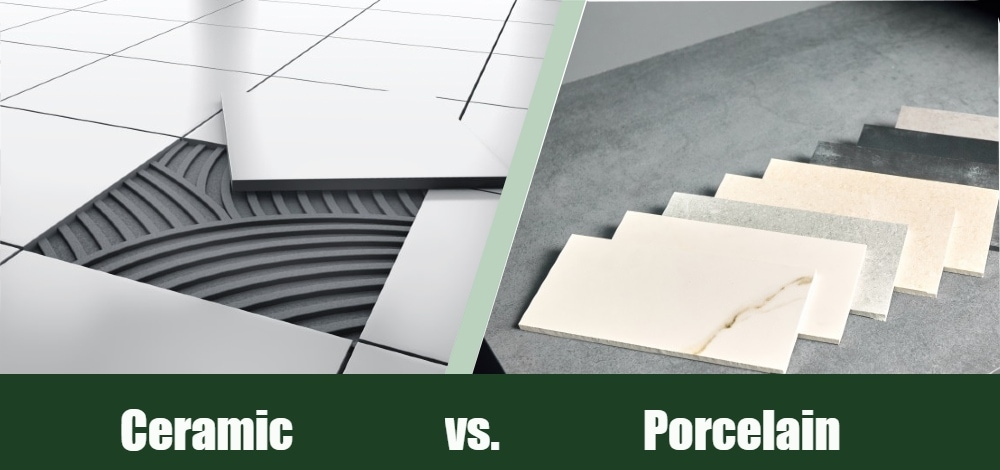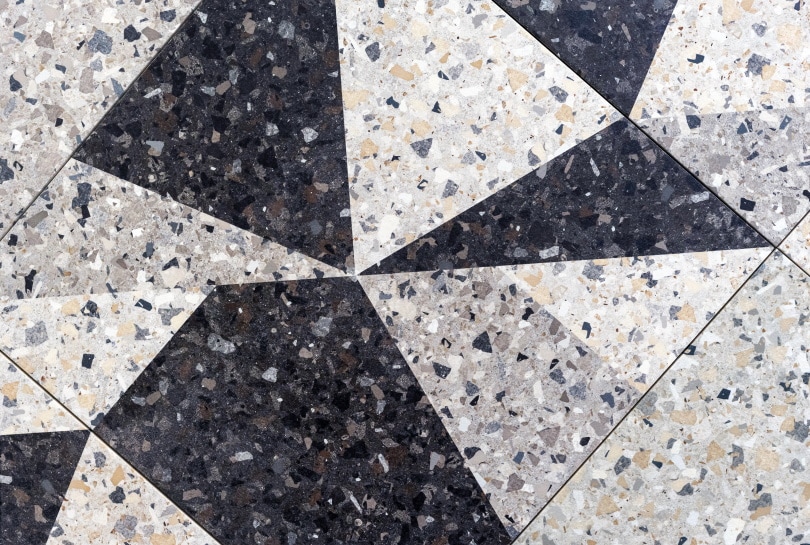Ceramic vs Porcelain Tiles for a Shower: Which to Choose?
-
Ed Malaker
- Last updated:


If you want to do some home improvement work, the bathroom is one of the best places to start. The grout between the tiles in your shower and even our countertops can degrade quickly. If you need to change the grout anyway, it’s the perfect time to change the tiles, but many people struggle with the type of tile they should purchase. Keep reading while we look at both ceramic and porcelain tiles and explain the characteristics of each to help you decide which one is better for your home.

Overview of Ceramic Tiles:

How Is Ceramic Tile Made?
A ceramic tile is usually a red or white clay baked in the oven at a high temperature to create a hard surface. It has a glaze coating that helps seal and protects the tile. The glaze helps stop the tile from absorbing stains, and it’s what gives the tile its color and pattern. However, the mud base is the primary downside, allowing it to absorb more water than other types of tiles.
What Is It Good for?
Ceramic tiles are an extremely popular choice for floors, countertops, walls, and more, and you can find them in several different sizes and a wide variety of colors and patterns. Ceramic tiles can be extremely inexpensive, costing as little as $0.50 per square foot, and they are quite durable, with many lasting between 75 and 100 years. Ceramic tile is easy to cut and shape with a standard tile cutter.

- Inexpensive
- Wide variety of colors and patterns
- It can last 75 years or more
- Easy to cut and shape
- Absorbs water
- Related Read: How to Drill a Hole in Ceramic (Step-by-Step DIY Guide)

Overview of Porcelain Tiles:

How Is Porcelain Tile Made?
Porcelain is extremely durable and originally came from China, starting as far back as the 15th century. Porcelain blends raw materials with tiny beads to create the desired consistency. The materials are then dried and pressed to achieve maximum strength. Once pressed, a manufacturer can form it into any size sheet. The sheets are allowed to dry more before applying colors and patterns, after which they bake the sheets at a high temperature.
What Is It Good for?
Porcelain is a great choice for interior and exterior surfaces and can use them to cover floors, walls, countertops, and more. Since they do not absorb water, they are a popular choice in wet areas like bathrooms and kitchens, but they can be considerably more expensive than other types of tiles, and you are unlikely to find them for less than $3 per square foot. However, like ceramic tiles, they’re extremely durable, and most will last 60 years or more.

- It doesn’t absorb water
- Extremely durable
- It can last 60 years or more
- Expensive
- Related Read: How to Drill Through Porcelain Tile Without Breaking It

What Are The Differences Between Ceramic and Porcelain Tiles?
Their construction is the biggest difference between ceramic and porcelain tile. Ceramic tile uses heated mud to create a hard surface. Manufacturers then paint it with a glaze that seals it and gives it its color and pattern. On the other hand, porcelain requires a much more complex process that allows manufacturers more control over the finished product. Porcelain tile is harder and will not absorb water, unlike ceramic which is vulnerable. The water absorption properties of ceramic make it vulnerable to chipping and cracking, especially in cold temperatures. However, ceramic is a great choice when you need a hard, durable surface at a low cost, as porcelain tends to cost several times more.

Types of Ceramic Tile
You might be surprised to learn that there are several types of ceramic tiles.
- Glazed Ceramic Tiles: Glaze ceramic tiles are the most popular, and they’re the kind we’ve been discussing. It has a vibrant color, and you can use it anywhere in your home.
- Unglazed Ceramic Tiles: Unglazed ceramic tiles do not have the colorful shiny finish of glazed ceramic tiles. Manufacturers usually make these slightly thicker since they are even more prone to absorbing water, but they provide a non-slip surface that many people prefer on floors.
- Vitrified Tiles: Future fried tiles are like glazed tiles, but they have additives to make them corrosive and scratch-resistant. These tiles are popular for repairing damaged stone surfaces.
- Mosaic Tiles: Mosaic tiles are extremely small and are usually less than one inch across. It’s a highly decorative type of tile that many people use to make images. Since the tiles are so small, they are harder to damage, and you use plenty of grout which helps create a non-slip surface when you install them on the floor.
- Quarry Tiles: Quarry tiles are essentially a tile version of a brick as the materials are similar, but they are usually harder than brick. They do not absorb water, so many builders use them to create a durable non-slip surface outdoors.
- Terracotta Tiles: Terra cotta tiles are typically used on rooftops and are similar to quarry tiles. Many of these tiles are still handmade, like in ancient times.

Types of Porcelain Tile
- Unglazed Porcelain Tiles: As the name suggests, unglazed porcelain tiles have no coating, so they have a matte appearance and usually create a non-slip surface.
- Glazed Porcelain Tiles: Once the porcelain tiles are finished baking, many manufacturers will add glazing as a second step to create a shiny tile that looks good in any home. The glazing also helps protect the tile and may add additional colors or patterns.
- Polished Porcelain Tiles: Polished porcelain tiles also have an attractive shine but are created differently from glazed porcelain tiles. As the name suggests, manufacturers sand these tiles with mild abrasive until the rough surface turns to a shine.
- Double Charged Porcelain Tiles: Double charged porcelain tiles use different types of clay to create unique designs. Manufacturers can make these tiles glazed, unglazed, or polished.
- Full Body Porcelain Tiles: Full-body porcelain tiles have the same color and pattern throughout the body of the tile. If these tiles are chipped or scratched, it’s more difficult to see because the same color resides below, so they are a great choice for areas that receive a lot of traffic.
- Textured Porcelain Tiles: Manufacturers use textured porcelain tiles to imitate stone and other surfaces so you can use them to replace these materials if they are damaged.

What Tile Should I Use in My Shower?
Porcelain is the obvious choice to cover the surfaces in your shower as it doesn’t absorb moisture and is extremely durable. However, the high cost of porcelain tile frequently makes builders look for a cheaper solution. Most people use ceramic tiles on the walls to keep the cars down. The ceramic will absorb a small amount of water and may become softer, but temperatures usually don’t get that cold in the bathroom, so there’s little risk of chipping or cracking. The walls don’t have to deal with a lot of force, and they will dry out between showers, so the ceramic makes a great choice and will usually last many years.
Since the floor sees a lot more water and must also withstand the weight of the people standing on it, builders usually opt for porcelain tiles in this part of the shower, though a ceramic mosaic tile can make a good second choice.
You might also be interested in: 5 Different Types of Shower Diverter Valves & Their Differences

Conclusion
If you are about to tile a new shower, we highly recommend glazed ceramic tiles for the walls as they strike a good balance between durability and cost. However, if you need something on the floor of your shower, we recommend you opt for the more expensive and more durable porcelain tiles.
See also: 10 Best Shower Wall Materials: Pros & Cons (Guide With Pictures)
Featured Image Credit: Left: Ceramic Tiles: Boris Rabtsevich, Shutterstock | Right: Porcelain Tiles: RYosha, Shutterstock
Contents